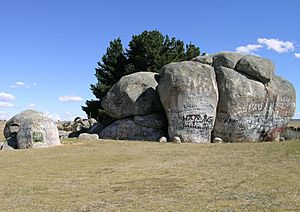Captain Thunderbolt's Rock facts for kids
Quick facts for kids Thunderbolt's Rock |
|
|---|---|
 |
|
| Location | New England Highway, Uralla, Uralla Shire, New South Wales, Australia |
| Owner | Uralla Shire Council |
| Official name: The Captain Thunderbolt Sites - Thunderbolt's Rock; Split Rock; Big Rock | |
| Type | State heritage (landscape) |
| Designated | 20 July 2012 |
| Reference no. | 1889 |
| Type | Geological site or area |
| Category | Landscape - Natural |
| Lua error in Module:Location_map at line 420: attempt to index field 'wikibase' (a nil value). | |
Thunderbolt's Rock is a famous rock formation and picnic spot near Uralla, Australia. It's right next to the New England Highway. This place is also known as Split Rock or Big Rock. It's owned by the Uralla Shire Council.
Thunderbolt's Rock is part of a group of important historical places called The Captain Thunderbolt Sites. These sites are linked to a well-known Australian bushranger named Captain Thunderbolt. A bushranger was like an outlaw or highway robber who lived in the Australian bush.
Contents
The Story of Thunderbolt's Rock
This rock has a long history, especially with Captain Thunderbolt. It was a perfect spot for him to watch the road. From here, he could see people and coaches coming from far away.
A Bushranger's Hideout
In October 1863, Captain Thunderbolt, whose real name was Fred Ward, and his friend Fred Britten were waiting near Split Rock. They planned to stop the mail coach. But the police, Sergeant Stephen Gardiner and Senior Constable Reynolds, were with the mail.
A gun battle started. The bushrangers escaped through a muddy area called Church Gully. During their escape, Fred Ward was shot in his left knee. This injury was important later for identifying him.
Thunderbolt's Last Stand
Seven years later, in May 1870, Split Rock was part of Captain Thunderbolt's very last day. He met the Blanch family near the rock, took their belongings, and went with them to their inn. Soon after, he was caught.
It's not clear when the name changed from Split Rock to Thunderbolt's Rock. But the new name shows how strongly this place is connected to Captain Thunderbolt in local stories and history.
What Does Thunderbolt's Rock Look Like?
Thunderbolt's Rock is a huge group of granite rocks. It's about 7 kilometres (4.3 miles) south of Uralla, right on the New England Highway. It's a really impressive sight!
Current Condition and Features
The rock formation is in good condition. You might see some graffiti on it, but the rocks themselves are strong. There's a small car park and a picnic table behind the rocks. This makes it a great place for visitors to stop and enjoy the view.
Why is Thunderbolt's Rock Special?
Thunderbolt's Rock is very important to the history of New South Wales. It's listed on the New South Wales State Heritage Register. This means it's a protected historical site.
A Place of Firsts and Lasts
This rock was one of the first places where Fred Ward acted as a bushranger after escaping from Cockatoo Island in 1863. The gun battle here, where he was shot, helped shape how he operated as Captain Thunderbolt. He often preferred to run from the police rather than fight them head-on.
It was also involved in his final hold-up before he was caught.
A Recognised Landmark
Many people know Thunderbolt's Rock because of its link to Captain Thunderbolt. He is one of the most famous bushrangers in New South Wales. The site is well-marked and is a popular spot for tourists.
A Typical Bushranger Hideout
Thunderbolt's Rock is a great example of the kinds of places bushrangers used. It's a high point, offering excellent views of the surrounding countryside. This allowed them to see coaches and travellers approaching from a distance. Most roadside robberies happened in places without clear landmarks, so Thunderbolt's Rock is special because it's so easily recognisable.
It's also a striking landmark on the road between Uralla and Tamworth.

